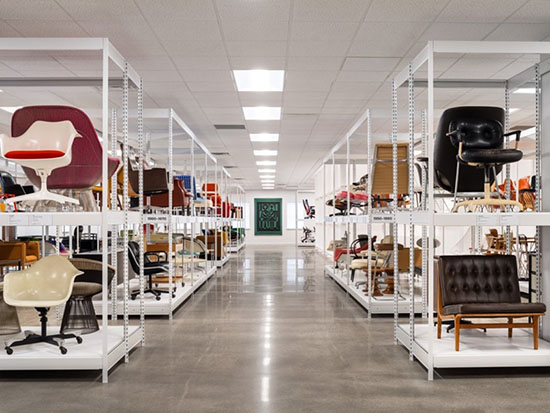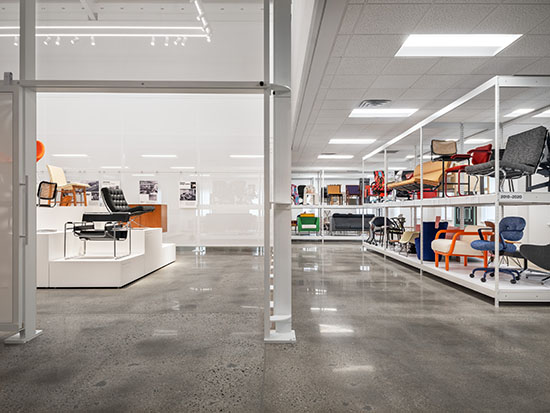MillerKnoll, a global leader in modern design, embraced the challenge of uniting and managing over one million objects following the 2021 merger of two legendary brands. By adopting CatalogIt, their archives team transformed their collections management: streamlining workflows, supporting a major new archives facility, and opening doors to greater access and collaboration.

MillerKnoll, headquartered in Zeeland, Michigan, is a global collective of iconic design brands that produce office furniture, home furnishings, and other equipment. The company formed in 2021 through the merger of Herman Miller and Knoll—two companies with long, distinguished histories in modern design. Together, they bring more than a century of design heritage into a unified archive that now houses over one million objects.
“We’re an archive, but our collection is actually more representative of a museum,” said Amy Ausherman, MillerKnoll’s Director, Archives and Brand Heritage, who spent nearly a decade overseeing Herman Miller’s collection before the merger. “It includes archival materials as well as publications, photography, and furniture.” After the addition of Sarah Wood, MillerKnoll’s dedicated Collections Manager, the team recognized it was time for a new tool to better catalog and manage their holdings.
When evaluating potential collections management systems (CMS), Sarah sought an easy-to-use interface that would allow them to add and update records on the go. "Previously, we were using Google Sheets, which is useful up to a point but can start to feel disorganized,” she shared. The combination of spreadsheets and scattered documentation lacked structure and consistency, making it difficult to manage, search, and grow their collection over time. With new items being added regularly across multiple sites, they needed a more efficient system. "CatalogIt immediately seemed to have the capabilities we needed!" said Sarah, who ultimately led their transition to the CMS.
Since implementing the CatalogIt platform, the MillerKnoll team has seen a notable shift in how they work. Previously, only one person managed and shared collection data in Google Sheets. Now, multiple team members can collaborate simultaneously. “It’s really streamlined the whole effort and makes things look more presentable—whether we’re sending materials to other institutions or sharing them internally,” said Sarah. She regularly uses the platform to generate professional-quality PDFs for condition reporting, which are especially useful when working with external partners. “That kind of organization [and presentation] helps, especially when you’re trying to get buy-in from people who are not involved in the day-to-day work,” she explained. “It goes a long way in instilling confidence, especially if we’re borrowing or lending something.”

Historically, MillerKnoll’s archives primarily served internal product research and development. But with the June 2025 opening of the MillerKnoll Archives—a new 12,000-square-foot facility at the Michigan Design Yard—the team faced a significant challenge. The space consolidates over one million items from Herman Miller, Knoll, and sibling brands into research, exhibition, and storage areas. While open to the public only through tours and approved research requests, the facility supports internal use and curated access for research, exhibitions, and special projects. To manage the growing collection and prepare the new physical space, they needed a system that could keep pace.
“We’re literally adding new objects to the collection every week,” said Sarah. To meet tight deadlines and maintain accuracy, the team relied on CatalogIt’s robust metadata capabilities and easy sorting. “Both the built-in metadata fields and the ability to sort easily were essential for us on the ground, not only to meet the deadline for preparing the space but also to do justice to the collection and the information we needed to capture along the way,” said Amy.
Under pressure to manage physical logistics and metadata simultaneously, Amy noted, “We were building the plane as we were flying it, and having a CMS was essential, even just to decide what we are putting on each rack or what we have to represent a certain era.” CatalogIt also proved essential for exhibition prep, helping the team organize metadata and streamline label creation. “We used CatalogIt extensively to ensure every field we wanted appeared on our labels,” said Sarah. “It really helped streamline that process.”
Managing furniture presented a unique challenge for the team. Unlike other types of objects in the collection, these pieces were constantly in circulation—loaned out to engineers, designers, and showrooms—which made them difficult to track. “There wasn’t a consistent method for tracking or recalling these items,” explained Sarah. “CatalogIt really filled that need for us.”
Now, for the first time, the team can quickly locate and identify relevant pieces for research or loan requests without relying on memory or physically searching the warehouse. “There are so many instances where I realize I no longer have to do things the old way,” Sarah said. “I can do it through CatalogIt now, which makes everything easier.” She can now confirm a piece’s availability, location, and loan status with just a few clicks.
Recently, while in the warehouse, Sarah was asked about a specific ottoman. Her first instinct was to search her memory, but then she remembered: “I can look it up on my phone!” Moments later, she’d found multiple examples in their records, identified the correct item through metadata, and tracked it down on the spot.
Looking ahead, Sarah is excited about the potential for broader internal engagement. “Eventually, I think we’ll be able to give other teams access to browse the collection themselves, and that’s going to get people really excited.”
As MillerKnoll’s collection continues to evolve, CatalogIt is providing the foundation for expanded access and deeper involvement across the organization. Sarah sees opportunities to increase visibility both internally and publicly. “Right now, we’re the keepers of the information,” she said, “but there’s a real opportunity to widen that circle of users and visitors. That sense of sharability feels inherent [with CatalogIt].”